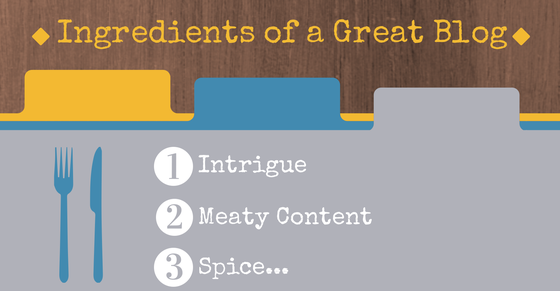
Posted By Sue Parente on June 12, 2014
Roll up your sleeves, don your chef's toque and join us for a whirlwind tour of Tier One's Blog Kitchen:
1. Whet your audience's appetite.
Blog writing isn't so different from other forms of web-writing, but it does have a few unique characteristics. Titles, subheader text and metatags text are all extremely important in blogs. Blog titles should make the reader itch to click. They should promise a clear benefit or intrigue the reader with the article's contents. Subhead text makes the post scannable but also improves its SEO.
Open your post with a bang, and don't waste words. Your opening paragraph either convinces the reader to continue, or bail. (See Slate on How People Read Online: Why You Won't Finish This Article.)
Use your blog platform's “SEO check” tool after you've drafted a post. Wordpress has several great plugins you can add if you don't already have one in place. Set a keyword for your post topic, then run the SEO tool. It'll flag simple ways to optimize your title, headers, keyword density and other post elements to improve the article's SEO value. (See 37 Tips for Optimizing Blogs.)
2. Keep your content meaty.
Great blogs do the heavy lifting for their readers. Make sure you research your posts thoroughly and cite any third-party sources backing up your claims. Curating great content that speaks to your expertise is both efficient as a blog tactic AND helps your audience know where to find the good stuff. Step up as a subject matter expert and guest-blog at other venues popular with your readers. This helps get your blog known and establishes your brand's thought leadership.
3. Spice things up.
The biggest sin of corporate blogs is blandness. Ask yourself honestly: is your blog guilty of Too Much Nice? Obviously it's inadvisable to go around bad-mouthing the competition, for example. But give your team permission to state strong opinions clearly, and let them dare to disagree. Like it or not, “clickbait” post titles are often provocative ones. Instead of naming your post “5 Ways to Write a Great Blog Post,” why not try something like “Blog Writing: 5 Ways You're Doing It Right?” Many blog editors test multiple headlines for the same post, just to see which approaches drives more clicks. You can extend this testing to the teaser copy you use in social media shares, too.
4. Balance is everything.
Chefs know how to pace a meal's flavors, balancing the salty with sweet or tart, juxtaposing interesting textures and playing with (and against) expectations. Adjust your content to offer a similar balance. Recurring features give your editorial calendar ballast; we particularly like Q&As that answer popular, real-world questions asked by your customers or prospects. Not only are these smart SEO-wise, they also give your blog the meat-and-potatoes substance readers crave.
At the same time, readers appreciate a palate-cleanser or an unexpected pairing. For the latter, why not draw a comparison between your product and something wholly different? You may be surprised at how a random-seeming metaphor – like comparing blog-writing to great cooking? – refreshes the topic and opens your prospects' eyes.
5. Make your post a visual feast, too.
Great cooks realize that presentation counts, too. A gorgeous meal starts with how the food looks. Similarly, a great blog post is well-organized, easily scanned, includes well-chosen images, and lends itself naturally to visual storytelling. Parse your blog post into a slideshow, a numbered list, or a well-designed infographic. Thinking visually not only increases your post's value; it can also help your content take on its next life in a new marketing channel. (See our post Hit Refresh: How to Extend the Life of Your Content.)
Want to Learn More? Check Out These Resources:
- ProBlogger: How to Write Great Blog Content
- HubSpot: How to Write a Blog Post: A Simple Formula to Follow



